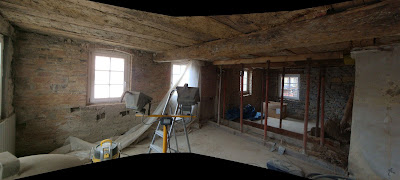Finally, an unrestricted view the length of the living room!
The newly exposed beams and clay plaster ceiling got prepared for replastering by cleaning off loose material and hacking out a channel alongside each beam, to allow space for securing mesh, if needed.
| Newly exposed beams. |
 |
| After the treatment exposing the edges of the beams. |
| Looking good! Loooong beams! |
I spent hours and hours using a belt sander on the beam which I'd spent hours and hours stripping paint from, and I'm pleased with the results (though my shoulders were not), although there are still cracks filled with paint. But remember, this was coated in about 4 or 5 layers of paint, some oil-based, some emulsion. Some final finishing sanding and some oiling, and this will be a beautiful piece of wood. Well, it already is!
Up in the attic, I continued removing floor boards. We now know these were laid on August 1st, 1952, by Adolf Wagner and Julius Finn (who died only recently), thanks to signatures under the boards. Lots of old grains and a couple of mouse nests. The usual stuff.
| Boards are in good condition, but I'm lifting them anyway. |
 |
| Adolf and Julius, 1952. |
We also had a meeting with our architect, and plans are afoot to resume work outside. We'll tender for the facade and external insulation work, and of course, the general builder has to come back and connect us to the sewer system, as well as dig a big hole to install a rain water cistern and prepare a patio area. BBQ season is coming!


